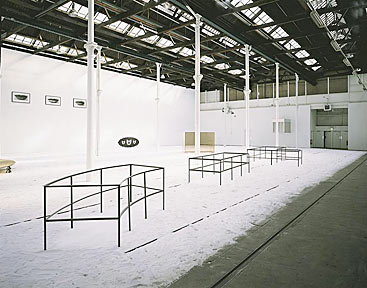
Born in 1956 in Cherbourg (FR)
Lives and works in Paris (FR)

1996
Stainless steel, grey paint, salt
Dimensions variables
Year of Purchase: 1997
Élisabeth Ballet produces installations that question in various ways the notion of space, its limits and the concrete form to be given to it within an existing space. Delta (1996) was devised for Tramway in Glasgow and is one of the Sugar Hiccup series also comprising two other works based on the same principle (made of wood, neon and steel, Cale (Block) is circular in shape and placed on the floor; Contrôle 3 is a kind of rectangular Plexiglas box); both materialize and bound closed empty spaces to which there is no physical access. Delta is a work made up of three structures of various shapes and sizes, aligned and spaced at regular intervals. These are firmly drawn structures made up of vertical and horizontal fencing or weft, and whose interior volume is empty. Painted in plain grey, they call for a special interpretation of the space. They circum¬scribe and cut off three empty spaces which only seem to be there to help the eye wander from one element to another. This arrange¬ment sometimes involves materials with a structure that actually contrasts with the form displayed – the first, curved enclosure is made with thin angle bars; the second is rectangular, and uses iron tubular fencing; the last one is a more complex affair made out of iron angle bars of various thicknesses. And while these closed forms block the way, Delta is paradoxically an open-ended work that does not impose itself on the place, but rather is deployed in such a way as to alter our perception of the exhibition space. Delta can be displayed on either a neutral or a salt-covered floor. When salt is spread out it provides a link between the different enclosed spaces. This device unifies the three elements making up the work, but more than that, it makes the viewer an integral part of it. The salt filling the empty space of the three enclosures stays spotless, making them even more inaccessible and sacred. Meanwhile, the salt trodden underfoot and soiled by the viewer produces a way around, a path to follow. It introduces a modicum of disorder within the arrangement by highlighting the boundaries between inside and outside. Quite apart from the visual impact, the salt also alters the spectator’s approach, his every step and the sound he makes, sounds which, as Michel de Certeau mentions, are then ‘shapings of spaces. They lay out a grid for the place.’ These spaces then become ‘places used’. For Élisabeth Ballet ‘walking around is akin to experimentation’. She thus brings all the visitor’s senses into play for them to really experience the work. These sculptures mark out an intermediate, impenetrable space, producing a demarcation, a kind of in-between thing. The work plays around with its own limits and seems to ask the questions: where is the inside? where is the outside? while coaxing us to find out for ourselves. And yet with Delta there is no real obstacle: these enclosures are really only skeletons opened up to the surrounding space.
Line Herbert-Arnaud